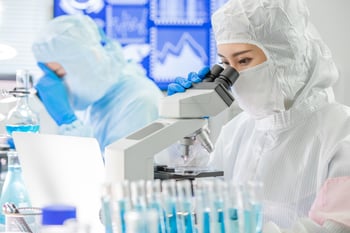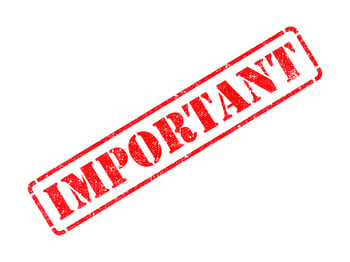One of the most important questions that any lab technician should be able to answer is: When should the lab bench be cleaned and disinfected?
A clean workspace is essential to maintain production and retain the integrity of an experiment or application. However, when a lab bench should be cleaned and disinfected often depends on what actions are being performed in the lab.
In general, experts recommend a routine cleaning and disinfection schedule. For many labs, that means cleaning and disinfecting after every shift, as well as after any type of spill or contamination occurs.
Some environments may require more aggressive cleaning and disinfection procedures. For example, in some pharmaceutical labs, the sterility of the drugs must be preserved. A lab that produces or handles chemotherapy drugs is one such lab because chemo drugs are considered hazardous and often contain carcinogens. Therefore, it’s usually recommended for lab workers to disinfect a bench before and after the production of each batch.
It is important to note as well that many labs have implemented more stringent cleaning procedures during the COVID-19 pandemic. The U.S. Centers for Disease Control and Prevention recommends that labs perform “site-specific and activity-specific risk assessment” to determine appropriate cleaning and sanitizing procedures, especially in labs that handle specimens associated with COVID-19.
When a lab bench should be cleaned and disinfected is not the only consideration when it comes to maintaining the integrity of a lab. Before a lab bench is cleaned or disinfected, it’s important to prep the area for cleaning and use the right cleaning agents for your application.
Before, During and After Cleaning
Working in a lab often requires the use of harsh chemicals when cleaning and disinfecting spaces. Before beginning, it’s always a good idea to have the proper type of protective gear available for personnel to protect them from these chemicals. This may include face masks, goggles, gloves, lab coats, coveralls and more.
beginning, it’s always a good idea to have the proper type of protective gear available for personnel to protect them from these chemicals. This may include face masks, goggles, gloves, lab coats, coveralls and more.
Also, before cleaning and disinfecting, remove or secure any exposed wires or electrical cords. Lab technicians should remove any small pieces of equipment as well, such as test tubes or containers, so they do not impede any cleaning efforts.
Lastly, double check that hand and eyewash stations are accessible and not blocked in the event you are exposed to cleaning agents.
During the cleaning and disinfecting process, it’s easy to only focus on the worksurface of the lab bench since this is the area that often sees the most use. But it’s also a good idea to include other areas of the lab bench as well when cleaning. These areas include frequently touched drawers and drawer handles, computers and keyboards, telephones, chairs, shelving and even items like pens.
Many experts recommend mopping the lab floor under the lab bench at least daily as well.
After cleaning is completed, it’s important to document the decontamination process so that the next employee who uses the lab bench is aware of the last time the workstation was cleaned.
Cleaning Agents
While the U.S. Centers for Disease Control recommends using a 10% bleach solution as the standard cleaning agent for effective disinfection, your lab may require or prefer other cleaning agents based on your application.
A 10% bleach solution is considered to be an intermediate-strength chemical germicide. This level of germicide will kill most bacteria and fungi, as well as inactivate most viruses. A high-level disinfection process, on the other hand, will kill all vegetative microorganisms. A low-level chemical germicide will kill some bacteria and fungi, but not all.
The level of sterility your lab requires will help you determine which cleaning agents you should use; however, it’s important to note that high-level disinfection is reserved for sterilizing items like medical devices. The U.S. Food and Drug Administration does not recommend using them on environmental surfaces such as lab benches or floors.
Important Considerations
Before cleaning and disinfecting your lab bench, it is very important to know which materials can withstand the harsh cleaning agents found in laboratories.
harsh cleaning agents found in laboratories.
Certain materials like epoxy resin and phenolic resin hold up well against chemicals, yet it’s not always recommended to use bleach on them because this harsh chemical can cause damage. The good news is that both epoxy resin and phenolic resin offer many advantages like high bacterial, fungal and moisture resistance.
Other materials like stainless steel hold up moderately well to chemicals, while materials like high pressure laminate do not hold up well at all.
Many manufacturers recommend using mild detergents or soap, along with hot water, for regular cleaning. However, if your application requires a more sterile environment it’s important to consult with your lab furniture’s manufacturer to determine which cleaning agents are appropriate for your lab bench.
In general, most manufacturers recommend avoiding sharp or abrasive tools that can damage the work surfaces.
Timing Is Everything
There’s a common saying, “Timing is everything.” The same can be said when it comes to preserving the integrity of your lab.
Cleaning and disinfecting plays an important role in accomplishing this. But, in order to be successful, lab technicians must clean and disinfectant lab benches on a regular basis and immediately after a spill or other contamination event occurs.
Working with an experienced lab bench manufacturer will also help ensure you are using the correct cleaning agents so that you can achieve the level of cleanliness you need in your lab.


